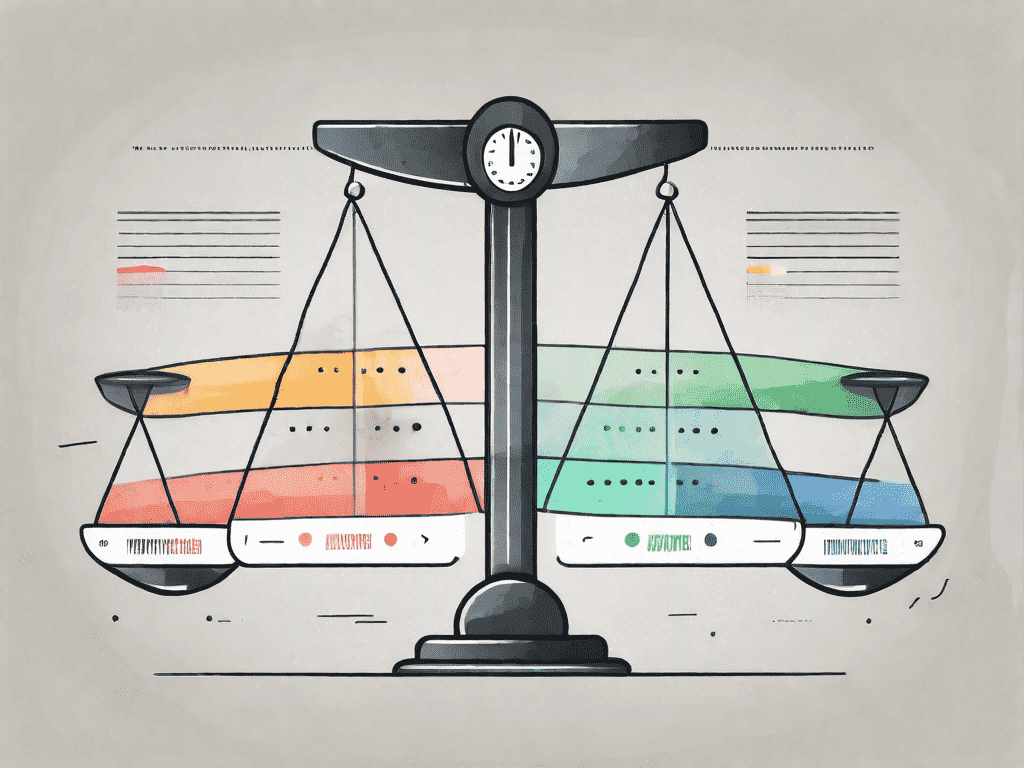
Understanding Loyalty: What is a Net Promoter Score?
Net Promoter Score (NPS) is a valuable metric used by businesses to measure customer loyalty and satisfaction. By understanding what NPS is and how it can be calculated, businesses can gain insight into their customers’ opinions and make strategic decisions to improve their overall performance. In this article, we will delve into the details of NPS, explore its significance, and discuss effective ways to enhance it.
Defining Net Promoter Score (NPS)
Net Promoter Score is a customer loyalty metric that was introduced by Fred Reichheld in 2003. It is based on the simple question: “On a scale of 0 to 10, how likely are you to recommend our company/product to a friend or colleague?” Respondents are then categorized into three groups:
- Promoters (score 9-10): These are highly satisfied customers who are likely to promote the brand to others.
- Passives (score 7-8): These customers are satisfied but not enthusiastic enough to actively promote the brand.
- Detractors (score 0-6): These customers are unsatisfied and may spread negative word-of-mouth.
NPS is calculated by subtracting the percentage of detractors from the percentage of promoters.
The Origin of NPS
Net Promoter Score originated from the realization that traditional customer satisfaction surveys fail to predict a customer’s loyalty to a particular brand. Reichheld and his team discovered that customers who give high ratings to a company are more likely to stay and recommend it to others, leading to long-term growth and success.
This realization sparked a paradigm shift in the way businesses measure customer satisfaction. Prior to the introduction of NPS, companies relied on complex and often convoluted metrics that failed to capture the essence of customer loyalty. NPS brought simplicity and clarity to the forefront, providing a clear and actionable metric that businesses could use to gauge customer sentiment and drive growth.
Reichheld’s groundbreaking research not only challenged the status quo but also revolutionized the way companies approach customer satisfaction. By focusing on the likelihood of recommendation, NPS shifted the focus from mere satisfaction to advocacy, recognizing the power of word-of-mouth in driving business success.
The Basic Calculation of NPS
The calculation of NPS is straightforward. Let’s assume that out of 100 respondents, 60 are promoters, 25 are passives, and 15 are detractors. To find the NPS, subtract the percentage of detractors (15%) from the percentage of promoters (60%), resulting in an NPS of 45%.
However, it is important to note that NPS calculations can vary depending on the specific needs and preferences of a company. Some businesses may choose to exclude passives from the calculation, focusing solely on the percentage of promoters and detractors. Others may assign different weights to each category, giving more importance to promoters or detractors based on their strategic goals.
Regardless of the specific calculation method, NPS provides businesses with a valuable metric that can be used to track customer loyalty over time and identify areas for improvement. By regularly measuring and monitoring NPS, companies can gain insights into customer satisfaction levels and take proactive steps to enhance the overall customer experience.
The Importance of Net Promoter Score
NPS is an essential metric as it provides valuable insights into customer loyalty and helps businesses understand their customer base better. By focusing on NPS, companies can identify areas for improvement, enhance customer satisfaction, and ultimately drive growth.
NPS and Customer Loyalty
Net Promoter Score serves as a strong indicator of customer loyalty. Promoters are more likely to continue using a company’s products or services, leading to increased customer retention and higher profits. Passives, on the other hand, are relatively indifferent and can easily be swayed by competing offerings, while detractors may actively discourage potential customers from engaging with the brand.
Customer loyalty is crucial for any business. It not only ensures repeat purchases but also promotes positive word-of-mouth, which can attract new customers. When customers are loyal to a brand, they become advocates, recommending it to their friends, family, and colleagues. This organic promotion can significantly impact a company’s reputation and bottom line.
Moreover, loyal customers tend to spend more money on a brand’s products or services. They trust the brand, feel a sense of attachment, and are more likely to explore additional offerings. This increased spending contributes to a company’s revenue growth and overall profitability.
NPS as a Business Performance Indicator
NPS not only gauges customer loyalty but also acts as a reflection of a company’s overall performance. A high NPS indicates that a business is effectively meeting customer needs, delivering exceptional experiences, and delighting its target audience. In contrast, a low NPS may signify areas that require attention and improvement.
When a company consistently achieves a high NPS, it demonstrates that it understands its customers and provides them with products or services that meet or exceed their expectations. This level of customer satisfaction is a testament to the company’s commitment to quality and customer-centricity.
On the other hand, a low NPS can be a wake-up call for businesses. It highlights areas where they may be falling short and failing to meet customer expectations. By analyzing the feedback provided by detractors and passives, companies can identify specific pain points and take corrective actions to improve their offerings.
Furthermore, NPS can also serve as a benchmark for comparing a company’s performance against its competitors. By tracking NPS over time and comparing it with industry averages, businesses can gain insights into their relative position in the market. This information can guide strategic decision-making and help companies stay ahead of the competition.
In conclusion, Net Promoter Score is a valuable metric that goes beyond measuring customer loyalty. It provides businesses with a holistic view of their performance and acts as a compass for continuous improvement. By leveraging NPS insights, companies can enhance customer satisfaction, drive growth, and build a strong and loyal customer base.
How to Improve Your Net Promoter Score
Although NPS provides valuable insights, simply monitoring it is not enough. To drive customer loyalty and improve NPS, businesses must actively work towards creating positive experiences and fostering customer satisfaction.
One way to improve your Net Promoter Score is by delivering exceptional customer service at every touchpoint. This means going above and beyond to meet customer needs, resolving issues promptly, and providing personalized assistance. By training and empowering your employees to deliver outstanding service, you will create loyal customers who will become brand advocates.
But exceptional customer service is just the beginning. To truly improve your NPS, you need to actively encourage customer feedback. Actively seeking customer feedback is crucial for improving NPS. Provide avenues for customers to share their opinions and suggestions, such as surveys, feedback forms, and social media engagement. Analyze the feedback received and use it to identify areas for improvement. Let your customers know that their feedback matters and that you are committed to making necessary changes to enhance their experience.
However, improving your Net Promoter Score is not a one-time effort. It requires continuous monitoring and improvement. Regularly assess your customer service processes and identify any bottlenecks or pain points that may be affecting customer satisfaction. Implement strategies to address these issues and constantly strive to exceed customer expectations.
Another way to improve your NPS is by personalizing the customer experience. Tailor your interactions and communications to each individual customer, making them feel valued and appreciated. Use customer data and insights to anticipate their needs and preferences, and proactively offer solutions or recommendations.
Furthermore, it’s important to create a company culture that prioritizes customer satisfaction. Foster a customer-centric mindset among your employees and ensure that everyone understands the importance of delivering exceptional service. Recognize and reward employees who consistently go above and beyond to delight customers.
In addition to delivering exceptional service, consider implementing loyalty programs or incentives to encourage customers to become promoters of your brand. Offer exclusive discounts, rewards, or special access to loyal customers as a way to show appreciation for their support and encourage them to spread positive word-of-mouth.
Lastly, don’t forget to regularly communicate with your customers. Keep them informed about any updates, improvements, or new offerings that may be relevant to them. By staying engaged with your customers, you can build stronger relationships and increase their likelihood of becoming promoters.
Misconceptions About Net Promoter Score
While NPS is a powerful tool, it is essential to address some misconceptions surrounding its usage.
The Net Promoter Score (NPS) has gained significant popularity in recent years as a metric to measure customer loyalty. It is a simple yet effective way to gauge how likely customers are to recommend a company or brand to others. However, it is important to recognize that NPS is not the only measure of customer loyalty.
NPS is Not the Only Measure of Customer Loyalty
While NPS provides valuable insights into customer loyalty, it should not be the sole indicator. Supplementing NPS with additional customer satisfaction metrics can provide a more comprehensive understanding of the overall customer experience and help identify specific areas for improvement.
Customer loyalty is a complex concept that encompasses various factors, including overall satisfaction, repeat purchases, and brand advocacy. While NPS focuses on the likelihood of customers recommending a company, it does not capture the complete picture of customer loyalty. By incorporating other metrics such as customer satisfaction scores, customer retention rates, and customer lifetime value, businesses can gain a more holistic view of their customers’ loyalty and identify areas where they can enhance the overall customer experience.
The Limitations of NPS
It is worth noting that NPS may not be suitable for every business or industry. Different industries may have unique factors that affect customer loyalty and satisfaction. Therefore, it is crucial to consider the specific circumstances and context before relying solely on NPS as a performance metric.
For instance, in industries where customers have limited choices or are locked into long-term contracts, NPS may not accurately reflect customer loyalty. Additionally, cultural differences and regional preferences can impact the validity of NPS scores in different markets. Therefore, businesses should take into account these limitations and consider using NPS in conjunction with other metrics to gain a more nuanced understanding of customer loyalty.
Furthermore, NPS is a retrospective measure that provides insights into past customer experiences. While it can help identify areas for improvement based on feedback from promoters, passives, and detractors, it may not provide real-time insights into customer sentiment. To address this limitation, businesses can complement NPS with real-time feedback mechanisms such as customer surveys, social media monitoring, and customer support interactions to capture a more up-to-date understanding of customer loyalty.
In conclusion, while NPS is a valuable tool for measuring customer loyalty, it is important to recognize its limitations and supplement it with other metrics to gain a comprehensive understanding of the overall customer experience. By considering the specific circumstances and context of the business, and incorporating additional customer satisfaction measures, businesses can make more informed decisions and drive continuous improvement in customer loyalty and satisfaction.
The Future of Net Promoter Score
As customer expectations continue to evolve, so too must the metrics used to measure loyalty. Businesses are constantly innovating and adapting their approaches to meet customer needs effectively. Similarly, customer loyalty metrics, including NPS, are evolving to capture a more accurate picture of customer sentiment.
Evolving Customer Expectations
Today’s customers have higher expectations regarding the quality of products, services, and overall experiences. They seek personalization, convenience, and seamless interactions. Adapting to these changing expectations will not only help increase NPS but also result in improved customer loyalty.
Innovations in Customer Loyalty Metrics
With advancements in technology and data analysis, businesses are developing innovative methods to understand and measure customer loyalty. These new approaches, such as sentiment analysis and predictive analytics, can provide deeper insights into customer behavior and help drive strategic decision-making.
In conclusion, Net Promoter Score is a powerful metric that enables businesses to gauge customer loyalty, identify areas for improvement, and make data-driven decisions. By understanding NPS, its significance, and how to improve it, businesses can enhance customer satisfaction, foster loyalty, and achieve long-term success.


